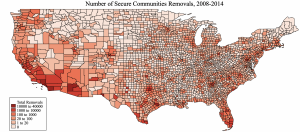Alongside Professor Pearlman and Professor Cynthia Bansak (of St. Lawrence University), I spent the summer researching US immigration policy and its economic effects. The Secure Communities program, the focus of our study, ran from 2008-2014 and contributed to a significant rise in deportations by sharing fingerprint data taken upon an individual’s arrest with U.S.’s Immigration and Customs Enforcement (ICE). As most of the deportations were men, we were interested in the rippling effects of the policy on immigrant networks that remain in the US—namely, the labor market patterns of foreign-born women.
In order to fully understand the scope of the topic, I conducted a literature review of the policy, learning about its history, roll out, and economic and social implications. In the process, I became aware of other immigration policies, such as 287(g) Agreements, that preceded the Secure Communities program. I analyzed a range of literature, from legal documents to ethnographic surveys, to understand these programs’ similarities, differences, and potential correlation. To visualize the extent of these policies, I created maps that documented the geographic dispersions of the policies at the US county level.

Counties with Active 287g Agreements at any point from 2005-2014. Data retrieved from Madeline Zavodny’s research.
In addition, we analyzed data on the labor market patterns of foreign-born women from 2005-2016, aiming to understand if there were any observable changes before estimating how much of this change could be attributed to the Secure Communities program.
Working with Professor Pearlman has given me a greater sense of and appreciation for the research process. We closely observed the disproportionate ways immigration policies affect individuals from different countries of origin, as well as residing in different US locations. The combination of qualitative and quantitative research involved in this process provided a multifaceted understanding of our topic, as immigration policy plays out on social, economic, and personal dimensions.

